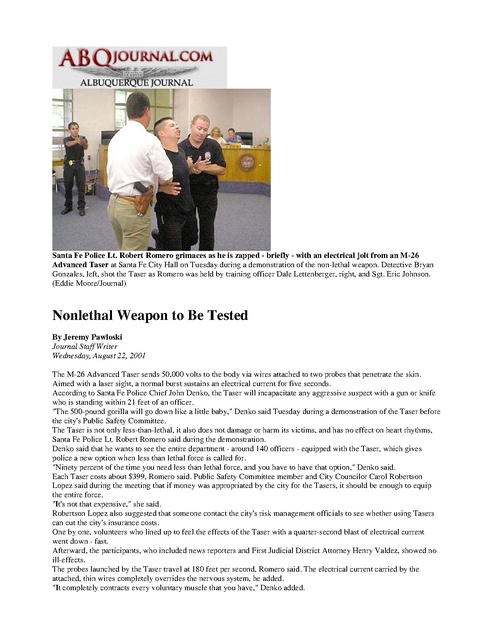Taser Santa Fe Press Conf 2001
Download original document:

Document text

Document text
This text is machine-read, and may contain errors. Check the original document to verify accuracy.
Santa Fe Police Lt. Robert Romero grimaces as he is zapped - briefly - with an electrical jolt from an M-26 Advanced Taser at Santa Fe City Hall on Tuesday during a demonstration of the non-lethal weapon. Detective Bryan Gonzales, left, shot the Taser as Romero was held by training officer Dale Lettenberger, right, and Sgt. Eric Johnson. (Eddie Moore/Journal) Nonlethal Weapon to Be Tested By Jeremy Pawloski Journal Staff Writer Wednesday, August 22, 2001 The M-26 Advanced Taser sends 50,000 volts to the body via wires attached to two probes that penetrate the skin. Aimed with a laser sight, a normal burst sustains an electrical current for five seconds. According to Santa Fe Police Chief John Denko, the Taser will incapacitate any aggressive suspect with a gun or knife who is standing within 21 feet of an officer. "The 500-pound gorilla will go down like a little baby," Denko said Tuesday during a demonstration of the Taser before the city's Public Safety Committee. The Taser is not only less-than-lethal, it also does not damage or harm its victims, and has no effect on heart rhythms, Santa Fe Police Lt. Robert Romero said during the demonstration. Denko said that he wants to see the entire department - around 140 officers - equipped with the Taser, which gives police a new option when less than lethal force is called for. "Ninety percent of the time you need less than lethal force, and you have to have that option," Denko said. Each Taser costs about $399, Romero said. Public Safety Committee member and City Councilor Carol Robertson Lopez said during the meeting that if money was appropriated by the city for the Tasers, it should be enough to equip the entire force. "It's not that expensive," she said. Robertson Lopez also suggested that someone contact the city's risk management officials to see whether using Tasers can cut the city's insurance costs. One by one, volunteers who lined up to feel the effects of the Taser with a quarter-second blast of electrical current went down - fast. Afterward, the participants, who included news reporters and First Judicial District Attorney Henry Valdez, showed no ill-effects. The probes launched by the Taser travel at 180 feet per second, Romero said. The electrical current carried by the attached, thin wires completely overrides the nervous system, he added. "It completely contracts every voluntary muscle that you have," Denko added. Romero said the manufacturer, Taser International, has never been sued successfully. There has been one death attributed to the Taser, a suicidal man who fell from the side a building when he was shot, he said. The Taser will pay for itself if the department is able to prevent one lawsuit by using a Taser instead of a gun to stop a suspect, Romero said. Santa Fe Deputy Police Chief Beverly Lennen said using a Taser could also cut the city's medical expenses by preventing police or suspect injuries during confrontations. Trained officers are slated to begin carrying Tasers during a testing period that will begin as soon as the City Attorney's Office approves the department's policy for their use, according to Lennen. Lennen said four Tasers have been donated by Taser International for testing purposes. Lennen said the department is looking at several options to pay for departmentwide use of Tasers, including grants and using gross receipt tax revenue. The department also will produce a cost-benefit analysis looking at how in the long term, Taser use could save the city money, she said.





